Analysis of Policies and Practices: Medication Support in Social Care
VerifiedAdded on 2020/07/22
|9
|2156
|327
Report
AI Summary
This report provides a comprehensive overview of medication support within social care settings. It begins by outlining relevant legislation, such as the Medicines Act 1968 and the Health Act 2006, emphasizing the regulatory framework governing medication handling. The report then details the roles and responsibilities of various staff members, including care/support workers, registered managers, nurses, and pharmacists, highlighting their crucial contributions to patient well-being. It explores how information about individual medications can be accessed through Medication Administration Record sheets, care plans, and medical records. The report further describes various routes of medication administration, different medication forms, and the use of equipment like spacers and nebulizers. It also covers the data that must be recorded, the safe storage of medications, and the proper disposal of unused or unwanted medications, ensuring the safety and well-being of both patients and the environment. The conclusion reinforces the importance of adhering to government regulations and monitoring practices to ensure patients' fast recovery and productive lives.
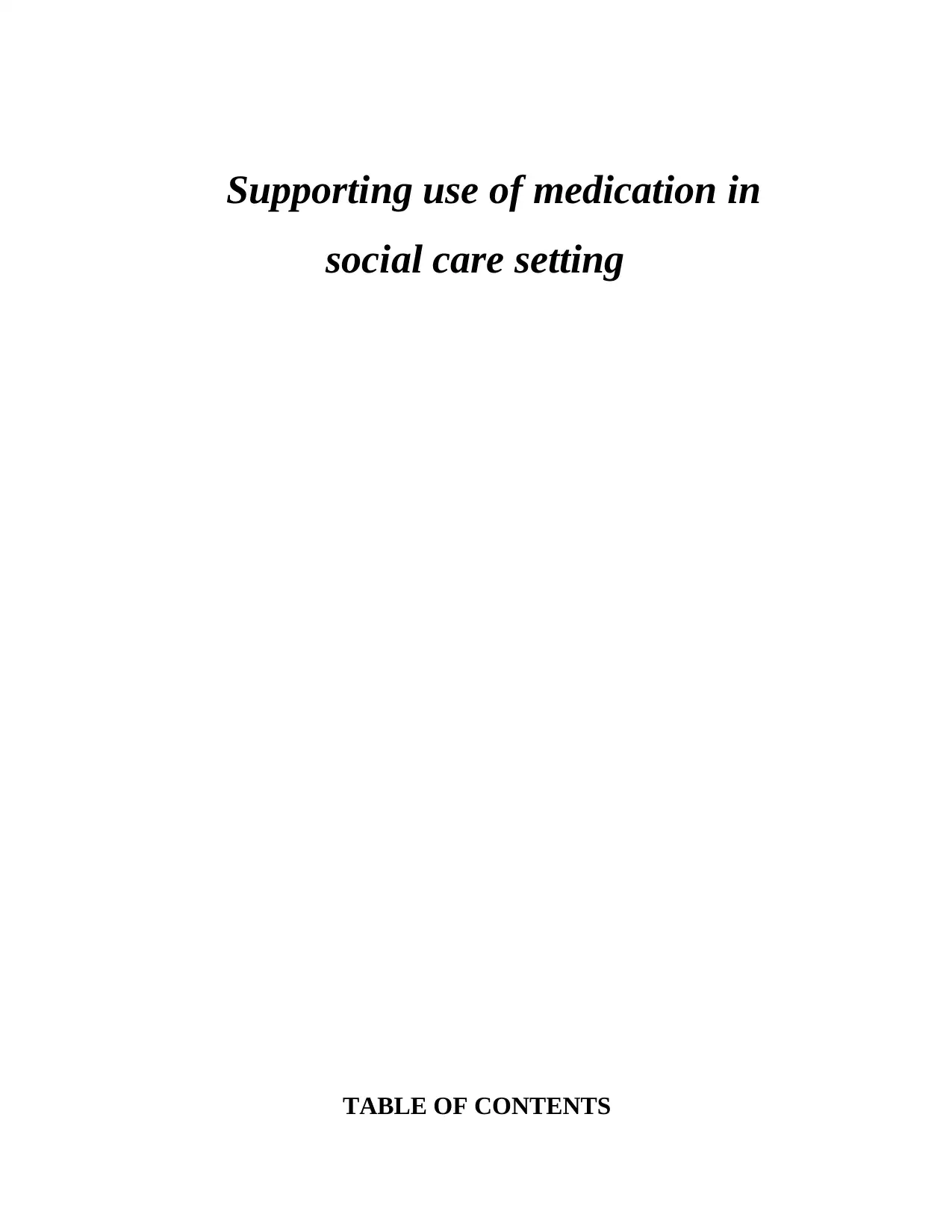
Supporting use of medication in
social care setting
TABLE OF CONTENTS
social care setting
TABLE OF CONTENTS
Paraphrase This Document
Need a fresh take? Get an instant paraphrase of this document with our AI Paraphraser
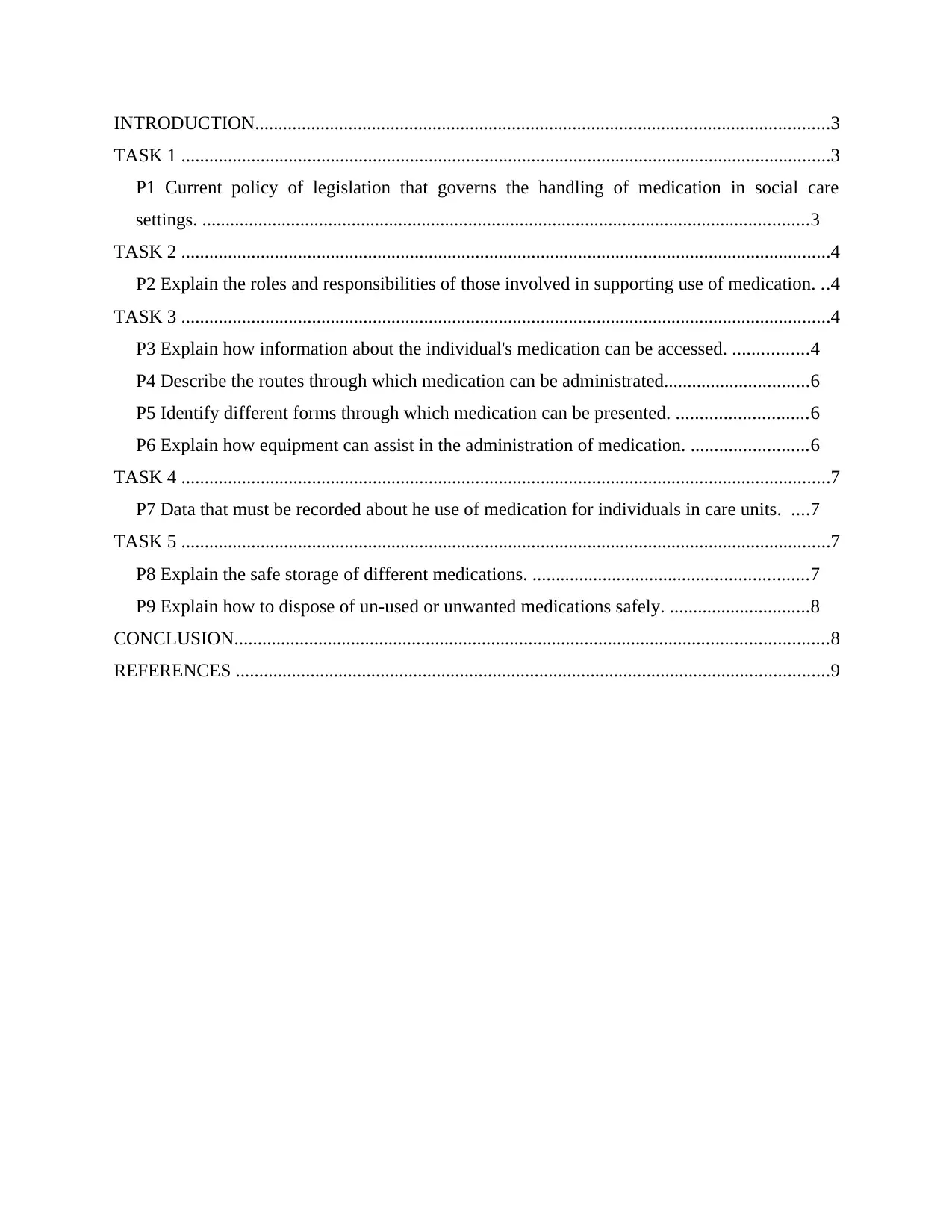
INTRODUCTION...........................................................................................................................3
TASK 1 ...........................................................................................................................................3
P1 Current policy of legislation that governs the handling of medication in social care
settings. ..................................................................................................................................3
TASK 2 ...........................................................................................................................................4
P2 Explain the roles and responsibilities of those involved in supporting use of medication. ..4
TASK 3 ...........................................................................................................................................4
P3 Explain how information about the individual's medication can be accessed. ................4
P4 Describe the routes through which medication can be administrated...............................6
P5 Identify different forms through which medication can be presented. ............................6
P6 Explain how equipment can assist in the administration of medication. .........................6
TASK 4 ...........................................................................................................................................7
P7 Data that must be recorded about he use of medication for individuals in care units. ....7
TASK 5 ...........................................................................................................................................7
P8 Explain the safe storage of different medications. ...........................................................7
P9 Explain how to dispose of un-used or unwanted medications safely. ..............................8
CONCLUSION...............................................................................................................................8
REFERENCES ...............................................................................................................................9
TASK 1 ...........................................................................................................................................3
P1 Current policy of legislation that governs the handling of medication in social care
settings. ..................................................................................................................................3
TASK 2 ...........................................................................................................................................4
P2 Explain the roles and responsibilities of those involved in supporting use of medication. ..4
TASK 3 ...........................................................................................................................................4
P3 Explain how information about the individual's medication can be accessed. ................4
P4 Describe the routes through which medication can be administrated...............................6
P5 Identify different forms through which medication can be presented. ............................6
P6 Explain how equipment can assist in the administration of medication. .........................6
TASK 4 ...........................................................................................................................................7
P7 Data that must be recorded about he use of medication for individuals in care units. ....7
TASK 5 ...........................................................................................................................................7
P8 Explain the safe storage of different medications. ...........................................................7
P9 Explain how to dispose of un-used or unwanted medications safely. ..............................8
CONCLUSION...............................................................................................................................8
REFERENCES ...............................................................................................................................9
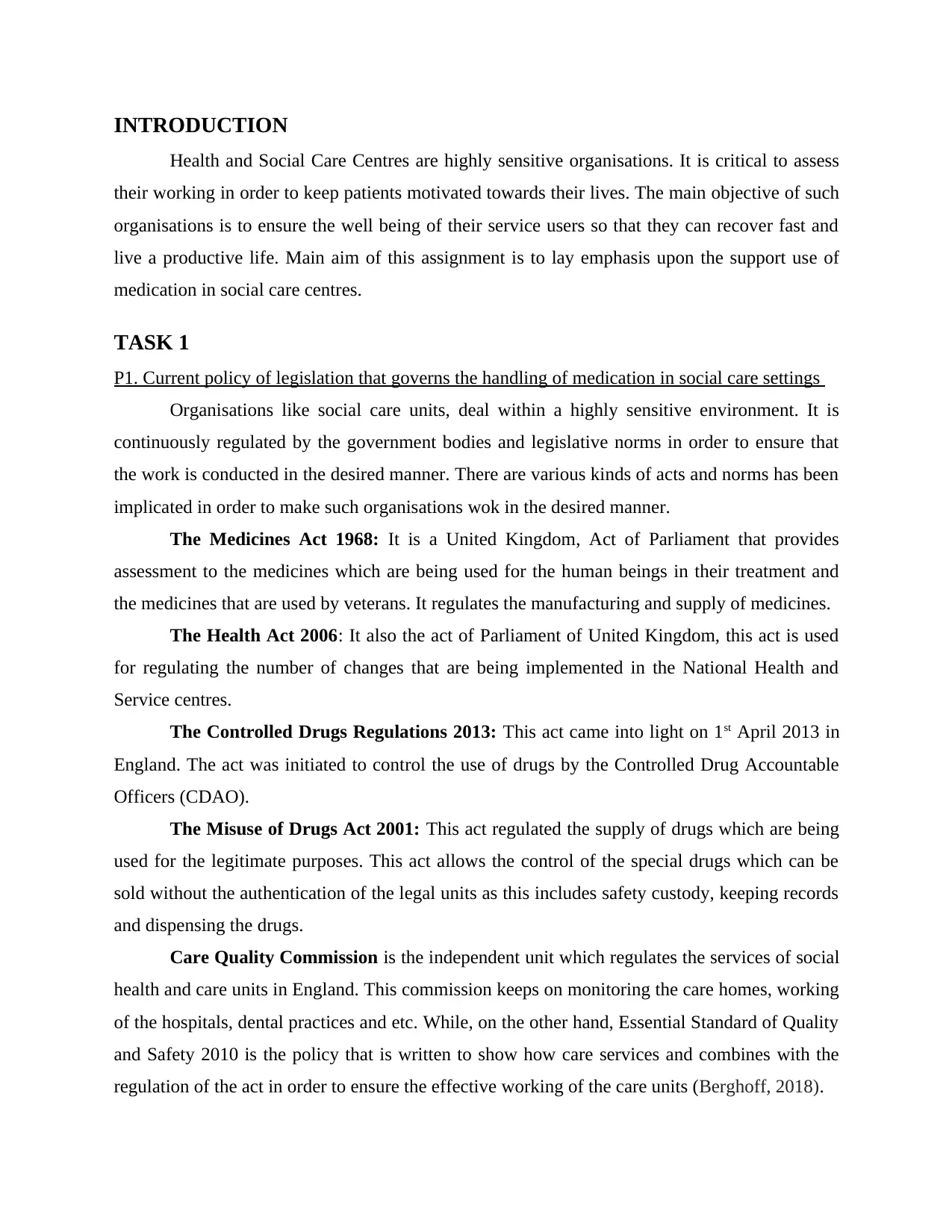
INTRODUCTION
Health and Social Care Centres are highly sensitive organisations. It is critical to assess
their working in order to keep patients motivated towards their lives. The main objective of such
organisations is to ensure the well being of their service users so that they can recover fast and
live a productive life. Main aim of this assignment is to lay emphasis upon the support use of
medication in social care centres.
TASK 1
P1. Current policy of legislation that governs the handling of medication in social care settings
Organisations like social care units, deal within a highly sensitive environment. It is
continuously regulated by the government bodies and legislative norms in order to ensure that
the work is conducted in the desired manner. There are various kinds of acts and norms has been
implicated in order to make such organisations wok in the desired manner.
The Medicines Act 1968: It is a United Kingdom, Act of Parliament that provides
assessment to the medicines which are being used for the human beings in their treatment and
the medicines that are used by veterans. It regulates the manufacturing and supply of medicines.
The Health Act 2006: It also the act of Parliament of United Kingdom, this act is used
for regulating the number of changes that are being implemented in the National Health and
Service centres.
The Controlled Drugs Regulations 2013: This act came into light on 1st April 2013 in
England. The act was initiated to control the use of drugs by the Controlled Drug Accountable
Officers (CDAO).
The Misuse of Drugs Act 2001: This act regulated the supply of drugs which are being
used for the legitimate purposes. This act allows the control of the special drugs which can be
sold without the authentication of the legal units as this includes safety custody, keeping records
and dispensing the drugs.
Care Quality Commission is the independent unit which regulates the services of social
health and care units in England. This commission keeps on monitoring the care homes, working
of the hospitals, dental practices and etc. While, on the other hand, Essential Standard of Quality
and Safety 2010 is the policy that is written to show how care services and combines with the
regulation of the act in order to ensure the effective working of the care units (Berghoff, 2018).
Health and Social Care Centres are highly sensitive organisations. It is critical to assess
their working in order to keep patients motivated towards their lives. The main objective of such
organisations is to ensure the well being of their service users so that they can recover fast and
live a productive life. Main aim of this assignment is to lay emphasis upon the support use of
medication in social care centres.
TASK 1
P1. Current policy of legislation that governs the handling of medication in social care settings
Organisations like social care units, deal within a highly sensitive environment. It is
continuously regulated by the government bodies and legislative norms in order to ensure that
the work is conducted in the desired manner. There are various kinds of acts and norms has been
implicated in order to make such organisations wok in the desired manner.
The Medicines Act 1968: It is a United Kingdom, Act of Parliament that provides
assessment to the medicines which are being used for the human beings in their treatment and
the medicines that are used by veterans. It regulates the manufacturing and supply of medicines.
The Health Act 2006: It also the act of Parliament of United Kingdom, this act is used
for regulating the number of changes that are being implemented in the National Health and
Service centres.
The Controlled Drugs Regulations 2013: This act came into light on 1st April 2013 in
England. The act was initiated to control the use of drugs by the Controlled Drug Accountable
Officers (CDAO).
The Misuse of Drugs Act 2001: This act regulated the supply of drugs which are being
used for the legitimate purposes. This act allows the control of the special drugs which can be
sold without the authentication of the legal units as this includes safety custody, keeping records
and dispensing the drugs.
Care Quality Commission is the independent unit which regulates the services of social
health and care units in England. This commission keeps on monitoring the care homes, working
of the hospitals, dental practices and etc. While, on the other hand, Essential Standard of Quality
and Safety 2010 is the policy that is written to show how care services and combines with the
regulation of the act in order to ensure the effective working of the care units (Berghoff, 2018).
⊘ This is a preview!⊘
Do you want full access?
Subscribe today to unlock all pages.

Trusted by 1+ million students worldwide
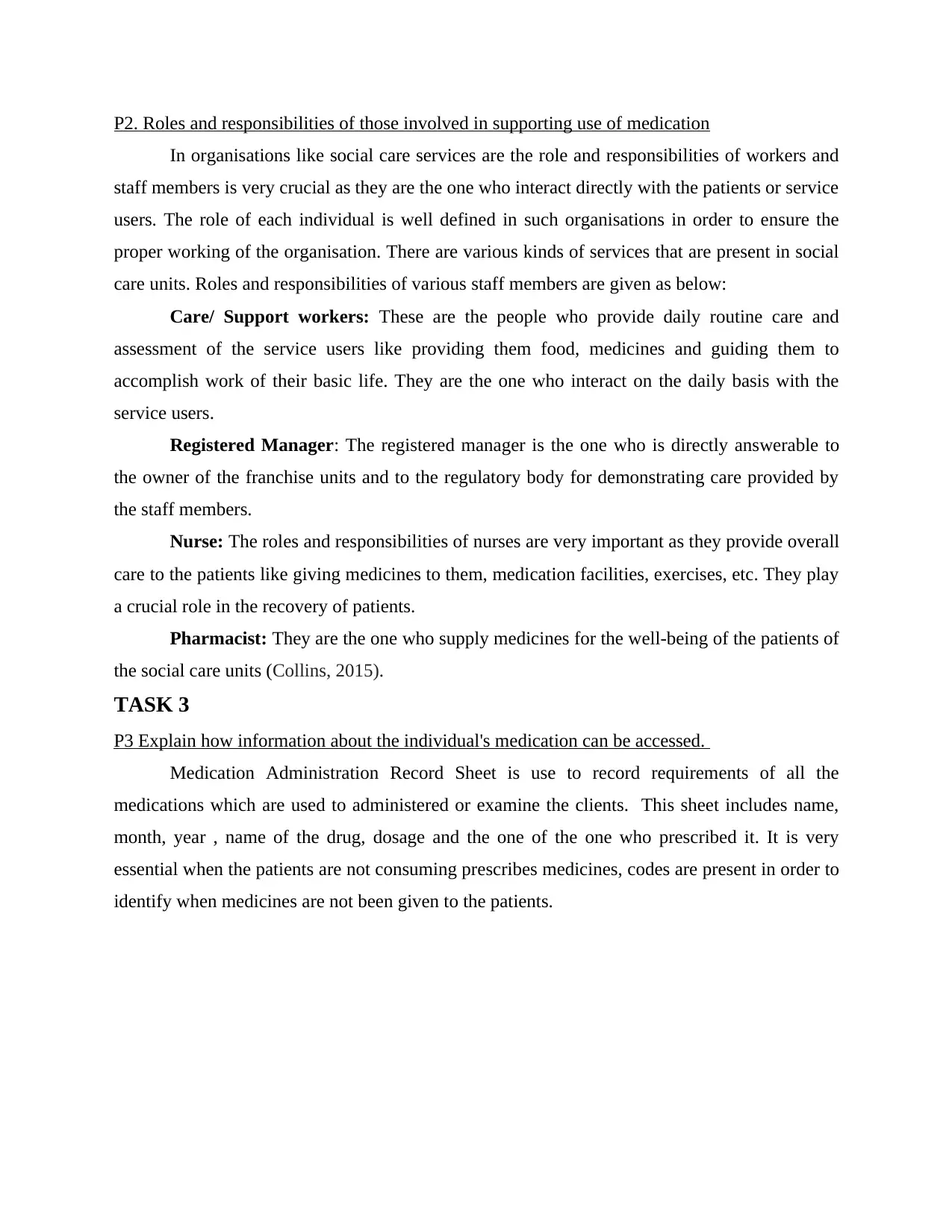
P2. Roles and responsibilities of those involved in supporting use of medication
In organisations like social care services are the role and responsibilities of workers and
staff members is very crucial as they are the one who interact directly with the patients or service
users. The role of each individual is well defined in such organisations in order to ensure the
proper working of the organisation. There are various kinds of services that are present in social
care units. Roles and responsibilities of various staff members are given as below:
Care/ Support workers: These are the people who provide daily routine care and
assessment of the service users like providing them food, medicines and guiding them to
accomplish work of their basic life. They are the one who interact on the daily basis with the
service users.
Registered Manager: The registered manager is the one who is directly answerable to
the owner of the franchise units and to the regulatory body for demonstrating care provided by
the staff members.
Nurse: The roles and responsibilities of nurses are very important as they provide overall
care to the patients like giving medicines to them, medication facilities, exercises, etc. They play
a crucial role in the recovery of patients.
Pharmacist: They are the one who supply medicines for the well-being of the patients of
the social care units (Collins, 2015).
TASK 3
P3 Explain how information about the individual's medication can be accessed.
Medication Administration Record Sheet is use to record requirements of all the
medications which are used to administered or examine the clients. This sheet includes name,
month, year , name of the drug, dosage and the one of the one who prescribed it. It is very
essential when the patients are not consuming prescribes medicines, codes are present in order to
identify when medicines are not been given to the patients.
In organisations like social care services are the role and responsibilities of workers and
staff members is very crucial as they are the one who interact directly with the patients or service
users. The role of each individual is well defined in such organisations in order to ensure the
proper working of the organisation. There are various kinds of services that are present in social
care units. Roles and responsibilities of various staff members are given as below:
Care/ Support workers: These are the people who provide daily routine care and
assessment of the service users like providing them food, medicines and guiding them to
accomplish work of their basic life. They are the one who interact on the daily basis with the
service users.
Registered Manager: The registered manager is the one who is directly answerable to
the owner of the franchise units and to the regulatory body for demonstrating care provided by
the staff members.
Nurse: The roles and responsibilities of nurses are very important as they provide overall
care to the patients like giving medicines to them, medication facilities, exercises, etc. They play
a crucial role in the recovery of patients.
Pharmacist: They are the one who supply medicines for the well-being of the patients of
the social care units (Collins, 2015).
TASK 3
P3 Explain how information about the individual's medication can be accessed.
Medication Administration Record Sheet is use to record requirements of all the
medications which are used to administered or examine the clients. This sheet includes name,
month, year , name of the drug, dosage and the one of the one who prescribed it. It is very
essential when the patients are not consuming prescribes medicines, codes are present in order to
identify when medicines are not been given to the patients.
Paraphrase This Document
Need a fresh take? Get an instant paraphrase of this document with our AI Paraphraser
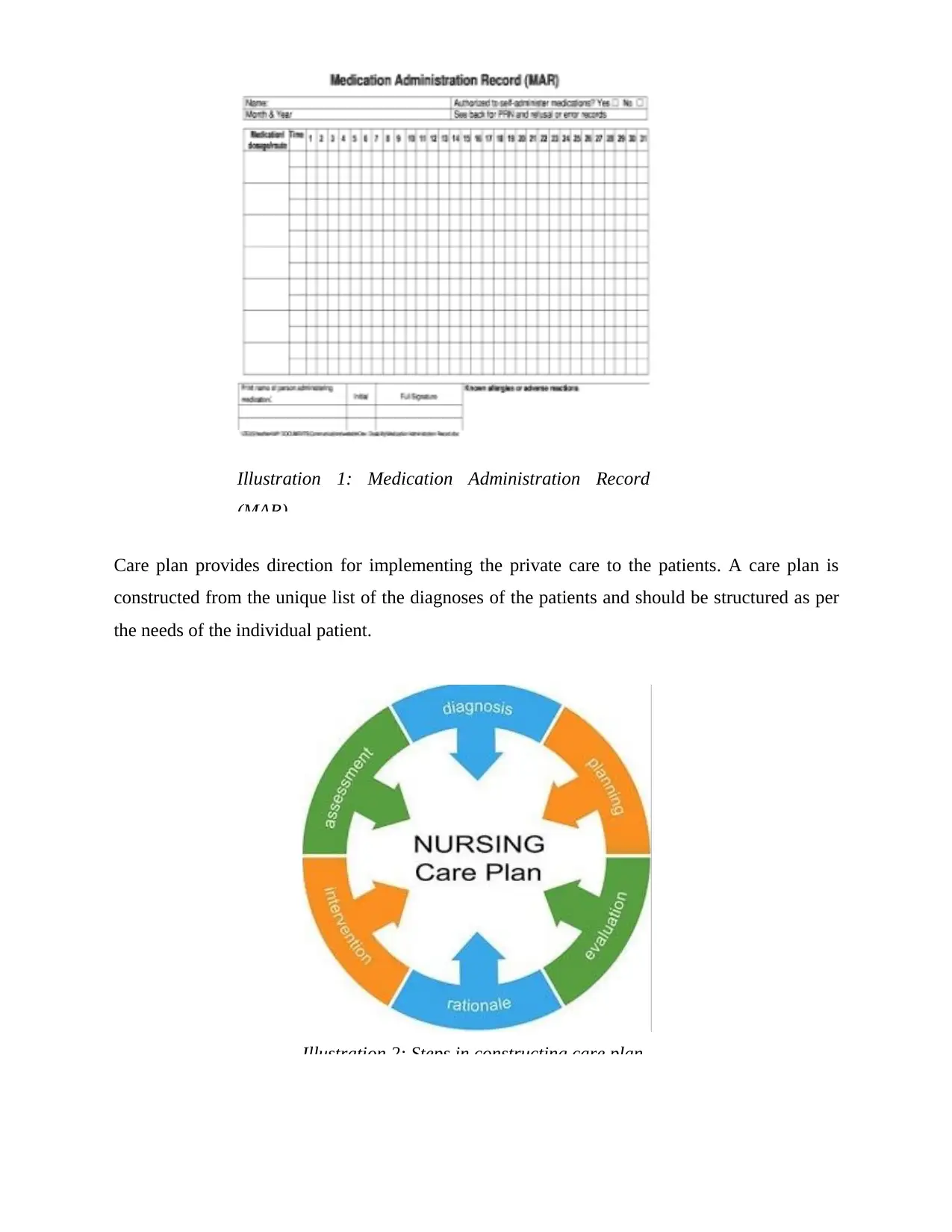
Care plan provides direction for implementing the private care to the patients. A care plan is
constructed from the unique list of the diagnoses of the patients and should be structured as per
the needs of the individual patient.
Illustration 1: Medication Administration Record
(MAR)
Illustration 2: Steps in constructing care plan.
constructed from the unique list of the diagnoses of the patients and should be structured as per
the needs of the individual patient.
Illustration 1: Medication Administration Record
(MAR)
Illustration 2: Steps in constructing care plan.
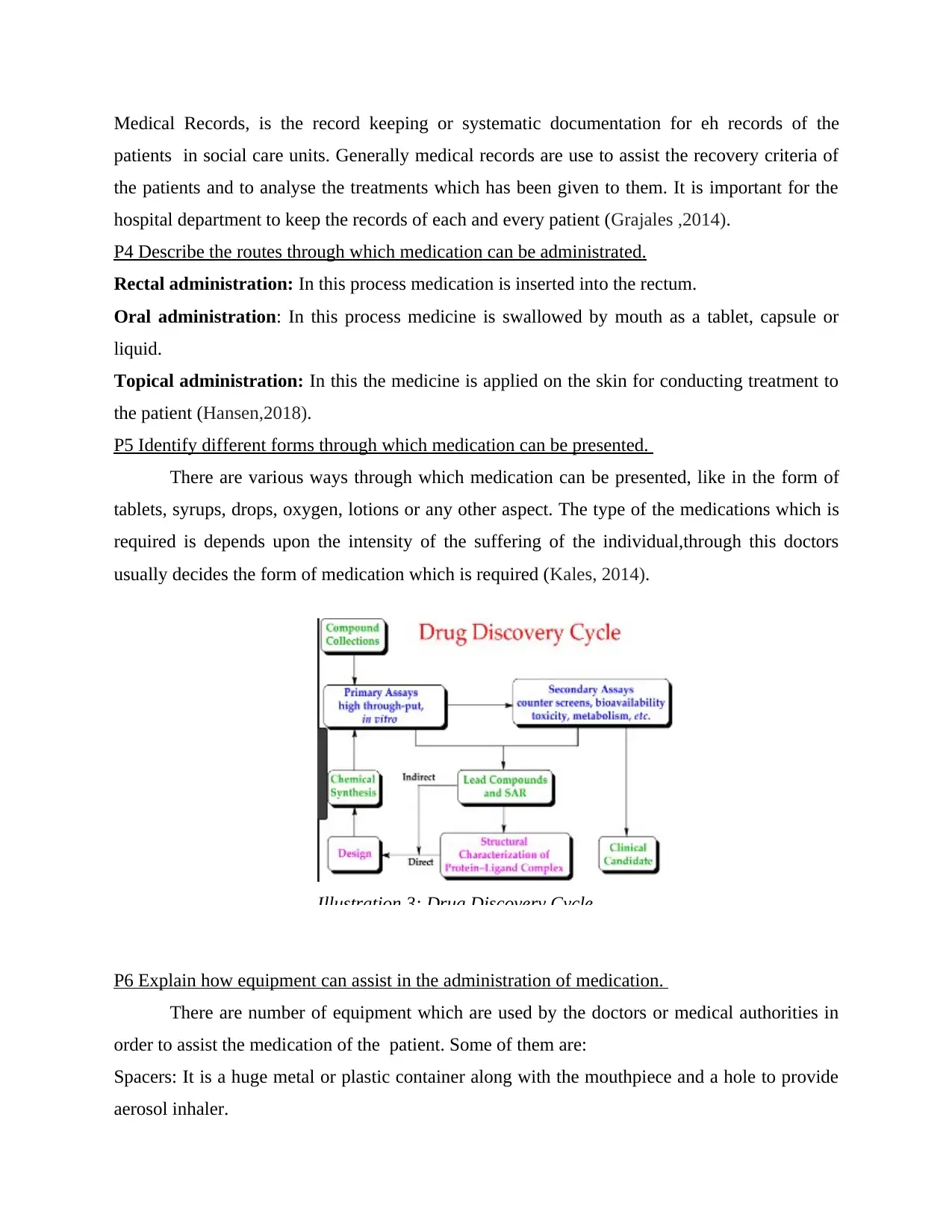
Medical Records, is the record keeping or systematic documentation for eh records of the
patients in social care units. Generally medical records are use to assist the recovery criteria of
the patients and to analyse the treatments which has been given to them. It is important for the
hospital department to keep the records of each and every patient (Grajales ,2014).
P4 Describe the routes through which medication can be administrated.
Rectal administration: In this process medication is inserted into the rectum.
Oral administration: In this process medicine is swallowed by mouth as a tablet, capsule or
liquid.
Topical administration: In this the medicine is applied on the skin for conducting treatment to
the patient (Hansen,2018).
P5 Identify different forms through which medication can be presented.
There are various ways through which medication can be presented, like in the form of
tablets, syrups, drops, oxygen, lotions or any other aspect. The type of the medications which is
required is depends upon the intensity of the suffering of the individual,through this doctors
usually decides the form of medication which is required (Kales, 2014).
P6 Explain how equipment can assist in the administration of medication.
There are number of equipment which are used by the doctors or medical authorities in
order to assist the medication of the patient. Some of them are:
Spacers: It is a huge metal or plastic container along with the mouthpiece and a hole to provide
aerosol inhaler.
Illustration 3: Drug Discovery Cycle
patients in social care units. Generally medical records are use to assist the recovery criteria of
the patients and to analyse the treatments which has been given to them. It is important for the
hospital department to keep the records of each and every patient (Grajales ,2014).
P4 Describe the routes through which medication can be administrated.
Rectal administration: In this process medication is inserted into the rectum.
Oral administration: In this process medicine is swallowed by mouth as a tablet, capsule or
liquid.
Topical administration: In this the medicine is applied on the skin for conducting treatment to
the patient (Hansen,2018).
P5 Identify different forms through which medication can be presented.
There are various ways through which medication can be presented, like in the form of
tablets, syrups, drops, oxygen, lotions or any other aspect. The type of the medications which is
required is depends upon the intensity of the suffering of the individual,through this doctors
usually decides the form of medication which is required (Kales, 2014).
P6 Explain how equipment can assist in the administration of medication.
There are number of equipment which are used by the doctors or medical authorities in
order to assist the medication of the patient. Some of them are:
Spacers: It is a huge metal or plastic container along with the mouthpiece and a hole to provide
aerosol inhaler.
Illustration 3: Drug Discovery Cycle
⊘ This is a preview!⊘
Do you want full access?
Subscribe today to unlock all pages.

Trusted by 1+ million students worldwide
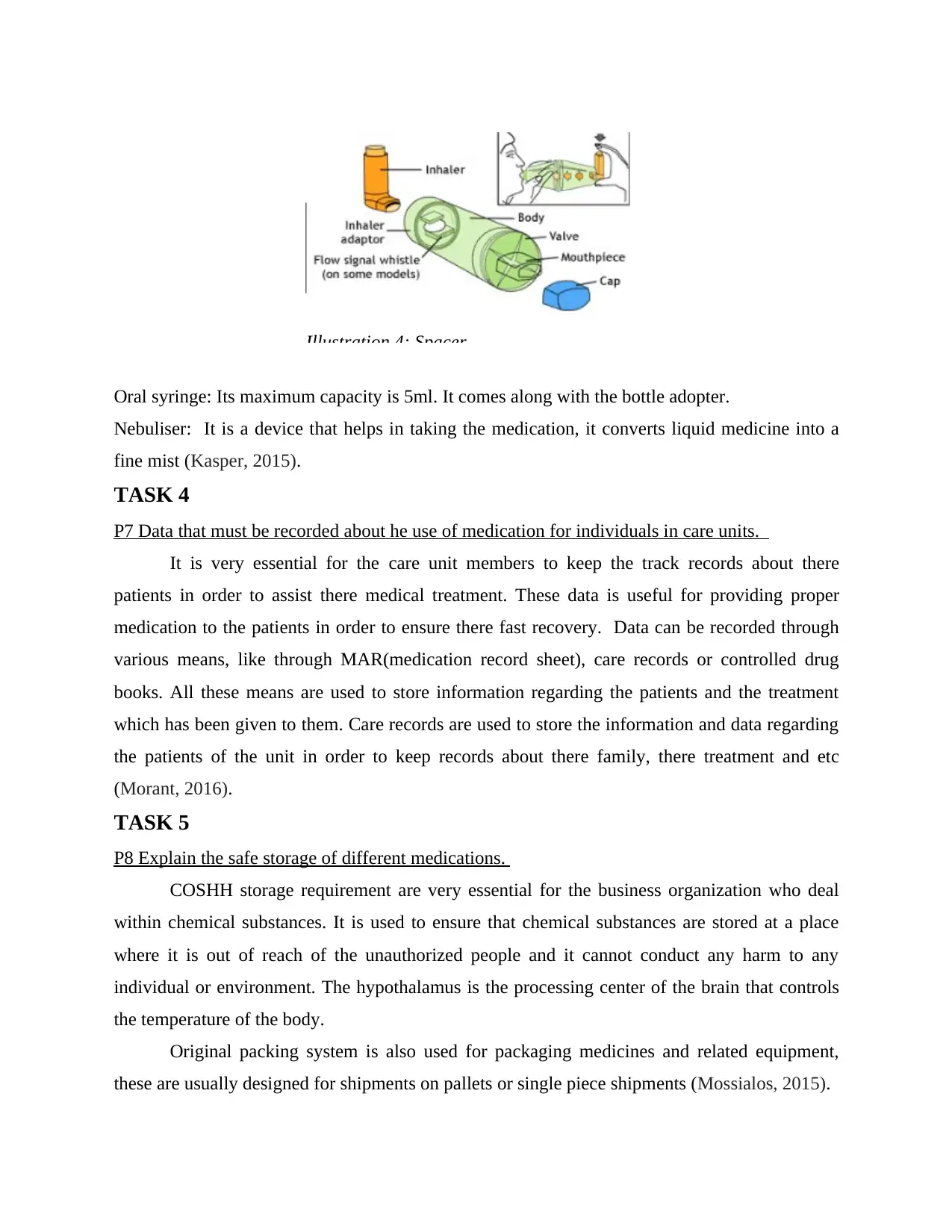
Oral syringe: Its maximum capacity is 5ml. It comes along with the bottle adopter.
Nebuliser: It is a device that helps in taking the medication, it converts liquid medicine into a
fine mist (Kasper, 2015).
TASK 4
P7 Data that must be recorded about he use of medication for individuals in care units.
It is very essential for the care unit members to keep the track records about there
patients in order to assist there medical treatment. These data is useful for providing proper
medication to the patients in order to ensure there fast recovery. Data can be recorded through
various means, like through MAR(medication record sheet), care records or controlled drug
books. All these means are used to store information regarding the patients and the treatment
which has been given to them. Care records are used to store the information and data regarding
the patients of the unit in order to keep records about there family, there treatment and etc
(Morant, 2016).
TASK 5
P8 Explain the safe storage of different medications.
COSHH storage requirement are very essential for the business organization who deal
within chemical substances. It is used to ensure that chemical substances are stored at a place
where it is out of reach of the unauthorized people and it cannot conduct any harm to any
individual or environment. The hypothalamus is the processing center of the brain that controls
the temperature of the body.
Original packing system is also used for packaging medicines and related equipment,
these are usually designed for shipments on pallets or single piece shipments (Mossialos, 2015).
Illustration 4: Spacer
Nebuliser: It is a device that helps in taking the medication, it converts liquid medicine into a
fine mist (Kasper, 2015).
TASK 4
P7 Data that must be recorded about he use of medication for individuals in care units.
It is very essential for the care unit members to keep the track records about there
patients in order to assist there medical treatment. These data is useful for providing proper
medication to the patients in order to ensure there fast recovery. Data can be recorded through
various means, like through MAR(medication record sheet), care records or controlled drug
books. All these means are used to store information regarding the patients and the treatment
which has been given to them. Care records are used to store the information and data regarding
the patients of the unit in order to keep records about there family, there treatment and etc
(Morant, 2016).
TASK 5
P8 Explain the safe storage of different medications.
COSHH storage requirement are very essential for the business organization who deal
within chemical substances. It is used to ensure that chemical substances are stored at a place
where it is out of reach of the unauthorized people and it cannot conduct any harm to any
individual or environment. The hypothalamus is the processing center of the brain that controls
the temperature of the body.
Original packing system is also used for packaging medicines and related equipment,
these are usually designed for shipments on pallets or single piece shipments (Mossialos, 2015).
Illustration 4: Spacer
Paraphrase This Document
Need a fresh take? Get an instant paraphrase of this document with our AI Paraphraser
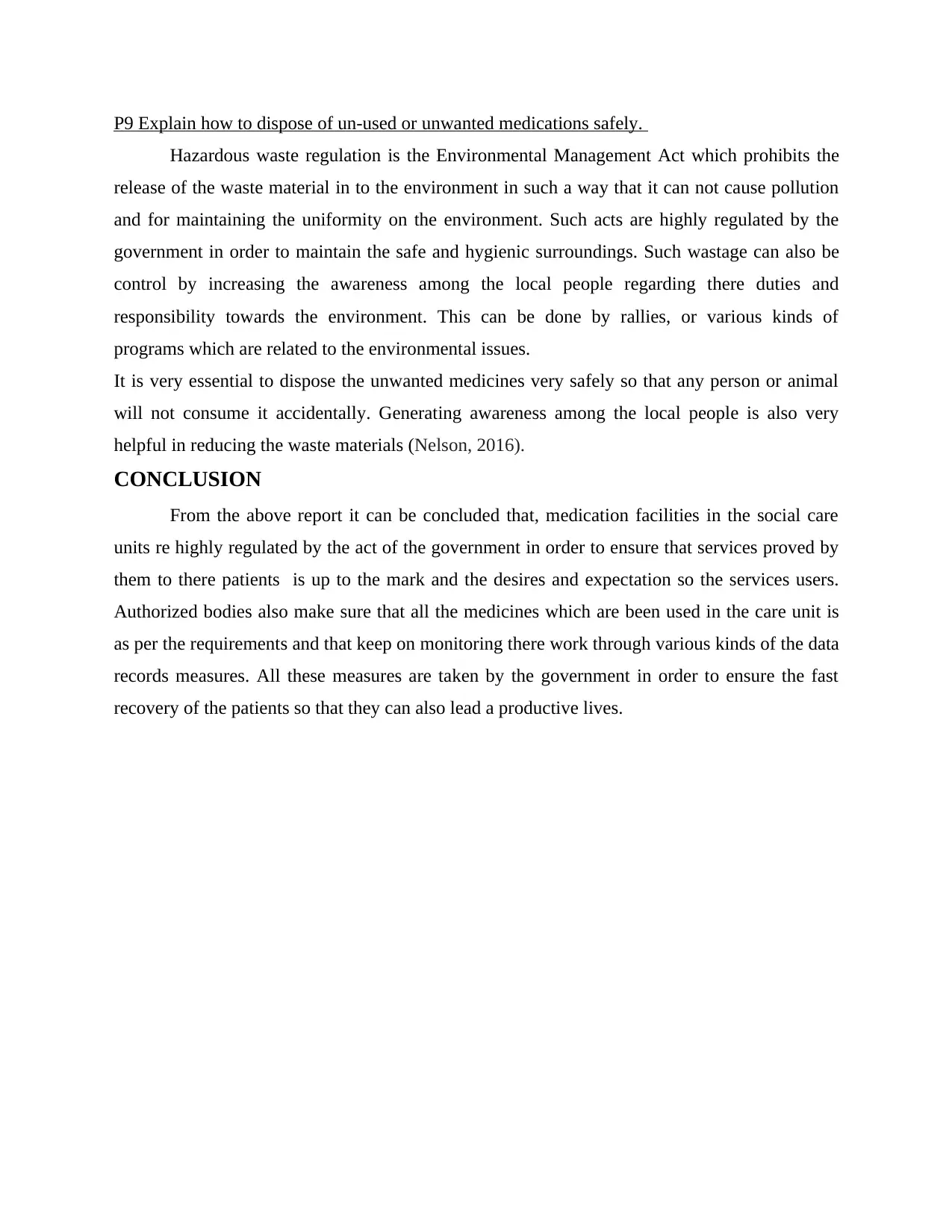
P9 Explain how to dispose of un-used or unwanted medications safely.
Hazardous waste regulation is the Environmental Management Act which prohibits the
release of the waste material in to the environment in such a way that it can not cause pollution
and for maintaining the uniformity on the environment. Such acts are highly regulated by the
government in order to maintain the safe and hygienic surroundings. Such wastage can also be
control by increasing the awareness among the local people regarding there duties and
responsibility towards the environment. This can be done by rallies, or various kinds of
programs which are related to the environmental issues.
It is very essential to dispose the unwanted medicines very safely so that any person or animal
will not consume it accidentally. Generating awareness among the local people is also very
helpful in reducing the waste materials (Nelson, 2016).
CONCLUSION
From the above report it can be concluded that, medication facilities in the social care
units re highly regulated by the act of the government in order to ensure that services proved by
them to there patients is up to the mark and the desires and expectation so the services users.
Authorized bodies also make sure that all the medicines which are been used in the care unit is
as per the requirements and that keep on monitoring there work through various kinds of the data
records measures. All these measures are taken by the government in order to ensure the fast
recovery of the patients so that they can also lead a productive lives.
Hazardous waste regulation is the Environmental Management Act which prohibits the
release of the waste material in to the environment in such a way that it can not cause pollution
and for maintaining the uniformity on the environment. Such acts are highly regulated by the
government in order to maintain the safe and hygienic surroundings. Such wastage can also be
control by increasing the awareness among the local people regarding there duties and
responsibility towards the environment. This can be done by rallies, or various kinds of
programs which are related to the environmental issues.
It is very essential to dispose the unwanted medicines very safely so that any person or animal
will not consume it accidentally. Generating awareness among the local people is also very
helpful in reducing the waste materials (Nelson, 2016).
CONCLUSION
From the above report it can be concluded that, medication facilities in the social care
units re highly regulated by the act of the government in order to ensure that services proved by
them to there patients is up to the mark and the desires and expectation so the services users.
Authorized bodies also make sure that all the medicines which are been used in the care unit is
as per the requirements and that keep on monitoring there work through various kinds of the data
records measures. All these measures are taken by the government in order to ensure the fast
recovery of the patients so that they can also lead a productive lives.
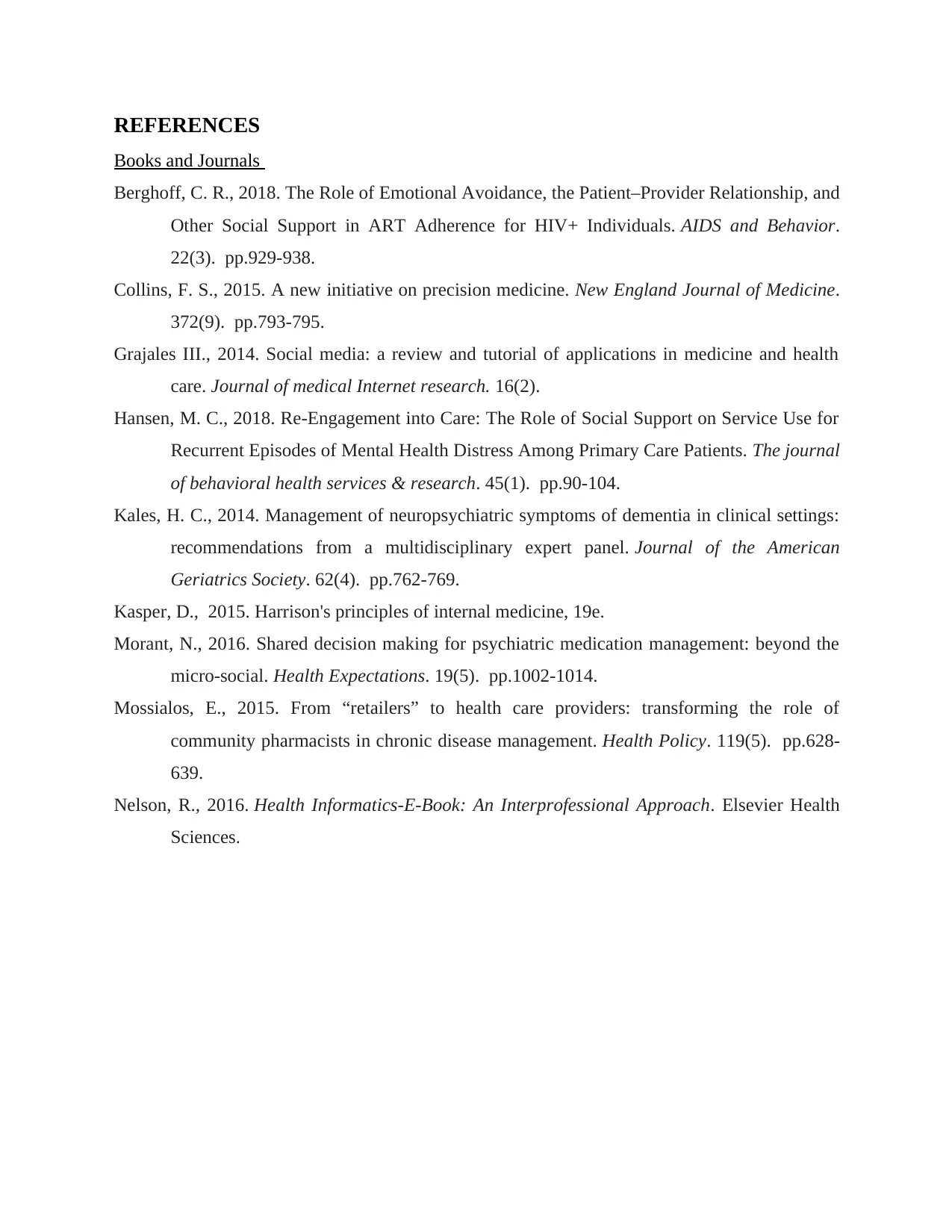
REFERENCES
Books and Journals
Berghoff, C. R., 2018. The Role of Emotional Avoidance, the Patient–Provider Relationship, and
Other Social Support in ART Adherence for HIV+ Individuals. AIDS and Behavior.
22(3). pp.929-938.
Collins, F. S., 2015. A new initiative on precision medicine. New England Journal of Medicine.
372(9). pp.793-795.
Grajales III., 2014. Social media: a review and tutorial of applications in medicine and health
care. Journal of medical Internet research. 16(2).
Hansen, M. C., 2018. Re-Engagement into Care: The Role of Social Support on Service Use for
Recurrent Episodes of Mental Health Distress Among Primary Care Patients. The journal
of behavioral health services & research. 45(1). pp.90-104.
Kales, H. C., 2014. Management of neuropsychiatric symptoms of dementia in clinical settings:
recommendations from a multidisciplinary expert panel. Journal of the American
Geriatrics Society. 62(4). pp.762-769.
Kasper, D., 2015. Harrison's principles of internal medicine, 19e.
Morant, N., 2016. Shared decision making for psychiatric medication management: beyond the
micro‐social. Health Expectations. 19(5). pp.1002-1014.
Mossialos, E., 2015. From “retailers” to health care providers: transforming the role of
community pharmacists in chronic disease management. Health Policy. 119(5). pp.628-
639.
Nelson, R., 2016. Health Informatics-E-Book: An Interprofessional Approach. Elsevier Health
Sciences.
Books and Journals
Berghoff, C. R., 2018. The Role of Emotional Avoidance, the Patient–Provider Relationship, and
Other Social Support in ART Adherence for HIV+ Individuals. AIDS and Behavior.
22(3). pp.929-938.
Collins, F. S., 2015. A new initiative on precision medicine. New England Journal of Medicine.
372(9). pp.793-795.
Grajales III., 2014. Social media: a review and tutorial of applications in medicine and health
care. Journal of medical Internet research. 16(2).
Hansen, M. C., 2018. Re-Engagement into Care: The Role of Social Support on Service Use for
Recurrent Episodes of Mental Health Distress Among Primary Care Patients. The journal
of behavioral health services & research. 45(1). pp.90-104.
Kales, H. C., 2014. Management of neuropsychiatric symptoms of dementia in clinical settings:
recommendations from a multidisciplinary expert panel. Journal of the American
Geriatrics Society. 62(4). pp.762-769.
Kasper, D., 2015. Harrison's principles of internal medicine, 19e.
Morant, N., 2016. Shared decision making for psychiatric medication management: beyond the
micro‐social. Health Expectations. 19(5). pp.1002-1014.
Mossialos, E., 2015. From “retailers” to health care providers: transforming the role of
community pharmacists in chronic disease management. Health Policy. 119(5). pp.628-
639.
Nelson, R., 2016. Health Informatics-E-Book: An Interprofessional Approach. Elsevier Health
Sciences.
⊘ This is a preview!⊘
Do you want full access?
Subscribe today to unlock all pages.

Trusted by 1+ million students worldwide
1 out of 9
Related Documents
Your All-in-One AI-Powered Toolkit for Academic Success.
+13062052269
info@desklib.com
Available 24*7 on WhatsApp / Email
![[object Object]](/_next/static/media/star-bottom.7253800d.svg)
Unlock your academic potential
Copyright © 2020–2025 A2Z Services. All Rights Reserved. Developed and managed by ZUCOL.





